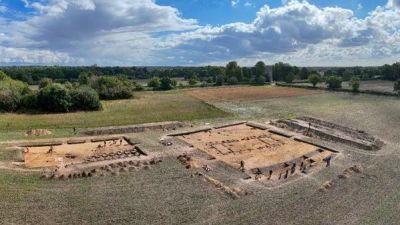'Hall of Kings' used by East Anglia's first royals found at Rendlesham, with links to Sutton Hoo

The discovery of the remains of a 1,400-year-old royal hall of the first kings of East Anglia has been described as a find of "international importance".
The elaborate timber hall was found during a community archaeological excavation at Rendlesham in Suffolk, and is believed to be linked to the royal families who were buried at Sutton Hoo.
The story of the treasures found within those burial mounds was depicted in the Netflix film The Dig, starring Ralph Fiennes, Carey Mulligan and Lily James.
The discovery of the hall confirms the Rendlesham site is the royal residence recorded in the writings of The Venerable Bede of the 8th century, and the wealthiest settlement of its time known in England.
The hall, measuring 23m by 10m, is part of a royal compound covering an area of six hectares, set within a larger settlement of over 50 hectares.
It was the seat of power from which a major province of the East Anglian kingdom, focused on the valley of the River Deben, was ruled for 150 years between AD 570 and AD 720.
Prof Christopher Scull, project’s principal academic advisor, said the results were "of international importance".
"Rendlesham is the most extensive and materially wealthy settlement of its date known in England, and excavation of the hall confirms that this is the royal residence recorded by Bede," added Prof Scull, an honorary visiting professor at the School of History, Archaeology and Religion at Cardiff University.
Bede’s writings identified Rendlesham as the place where the East Anglian King Aethelwold attended the baptism of King Swithelm of the East Saxons between the years AD 655 and 663.
Prof Scull added: “Only at Rendlesham do we have the wider settlement and landscape context of an early English royal centre together with an assemblage of metalwork that illuminates the lives and activities of its inhabitants across the social range.
"Together, these are radically re-writing our understanding of the sophistication, complexity and international connections of society at that time."
He praised the team of partners and volunteers which had worked on the project adding: "Their work is a major advance in our understanding of the early East Anglian kingdom and the wider North Sea world of which it was a part."
The excavations reveal:
the foundations of the large timber hall (first identified by aerial photography in 2015);
the perimeter ditch enclosing the royal compound;
the remains of food preparation and feasting which show vast quantities of meat - mainly beef and pork - were eaten there;
dress jewellery, personal items, fragments of glass drinking vessels and pottery;
traces of earlier settlement and activity on the site in the early Roman period (1st century AD) and the early Neolithic period (4th millennium BC)
The East Anglian kingdom, covering modern day Suffolk and Norfolk, was made up of several such regions and the kings travelled between them to rule and to be seen.
The excavated building would have been one of several similar monumental halls in the royal compound at Rendlesham.
From there, the first kings of the East Angles would have administered justice, received guests, hosted feasts, and distributed gifts and favours.
Previous archaeological investigations have recovered precious metalwork and coinage indicating the wealth and status of those who stayed there.
The nearby burial mounds at Snape and Sutton Hoo are two of the known princely burials associated with this royal settlement.
Over 250 volunteers from the local community were involved in the discovery, including young adults from the Suffolk Family Carers and Suffolk Mind, and over 100 local school children from Rendlesham, Eyke and Wickham Market primary schools.
Want a quick and expert briefing on the biggest news stories? Listen to our latest podcasts to find out What You Need To Know